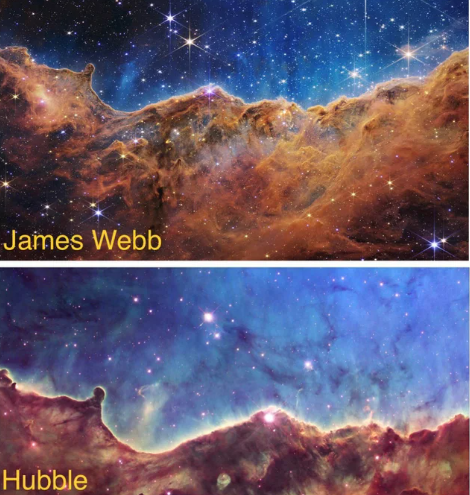NASA released the first science image from the James Webb Space Telescope (JWST) today during a press conference today with US President Joe Biden.
The image was of SMACS J0723.3-7327. What you see in the image is an area of space that includes the faintest objects ever observed in the infrared. This slice of the vast universe covers a patch of sky approximately the size of a grain of sand held at arm’s length by someone on the ground.. The light in this region goes back 13+ billion years.
Watch as I explore the detail in the full resolution version of the image. The detail is incredible.
How is JSWT different from Hubble?
JWST primarily sees the universe in the infrared part of the spectrum, while Hubble sees primarily in the optical and ultraviolet wavelengths (though it has some infrared capability). JWST is a successor to Hubble, not a replacement. It is going to see the universe differently from Hubble and deliver science images that will expand our understanding of the universe.

Comparison of the Carina Nebula in visible light (left) and infrared (right), both images by Hubble. In the infrared image, we can see more stars that weren’t visible before. Credit: NASA/ESA/M. Livio & Hubble 20th Anniversary Team (STScI)
The mirror on the JWST is also 6.25 times larger than the mirror on the Hubble Telescope. This will allow it to see deeper into space and resolve images with greater detail, in addition to seeing space in infrared.
First set of science images
NASA has announced the set of targets for the first science images to come from JWST. Hubble images all of the targets (except the exo-planet). Here’s a quick look at the expected targets from the perspective of Hubble.
Carina Nebula (also known as: NGC 3372)

The Carina Nebula, with an overall diameter of more than 200 light-years, is one of the outstanding features of the Southern-Hemisphere portion of the Milky Way. The diameter of the Keyhole ring structure shown here is about 7 light-years. | Credit: Hubble Telescope – NASA JPL
The Carina Nebula[7] or Eta Carinae Nebula[8] (catalogued as NGC 3372; also known as the Great Carina Nebula[9]) is a large, complex area of bright and dark nebulosity in the constellation Carina, and it is located in the Carina–Sagittarius Arm. The nebula is approximately 8,500 light-years (2,600 pc) from Earth. (Source: Wikipedia)
Southern Ring Nebula (also known as: NGC 3132)

Images of the Southern Ring Nebula reveal two stars close together within the nebulosity, one of 10th magnitude, the other 16th. The central planetary nebula nucleus (PNN) or white dwarf central star is the fainter of these two stars. | Credit: Hubble Telescope NASA
NGC 3132 (also known as the Eight-Burst Nebula,[2] the Southern Ring Nebula,[2] or Caldwell 74) is a bright and extensively studied planetary nebula in the constellation Vela. Its distance from Earth is estimated at about 613 pc. or 2,000 light-years. (Source: Wikipedia)
Galaxy group: Stephan’s Quintet

Four of the five galaxies in Stephan’s Quintet form a physical association, a true galaxy group, Hickson Compact Group 92, and will likely merge with each other. | Credit: Hubble Telescope, ESA NASA
Stephan’s Quintet is a visual grouping of five galaxies of which four form the first compact galaxy group ever discovered.[2] The group, visible in the constellation Pegasus, was discovered by Édouard Stephan in 1877 at the Marseille Observatory.[3] The group is the most studied of all the compact galaxy groups.[2] The brightest member of the visual grouping (and the only non-member of the true group) is NGC 7320, which has extensive H II regions, identified as red blobs, where active star formation is occurring. (Source: Wikipedia)
SMACS J0723.3-7327

SMACS J0723.3-7327 cluster. | Credit: This work is based on observations taken by the RELICS Treasury Program (GO 14096) with the NASA/ESA HST, which is operated by the Association of Universities for Research in Astronomy, Inc., under NASA contract NAS5-26555
SMACS J0723.3-7327 is a cluster of galaxies in the southern constellation Volan. This is an area that hasn’t been studied extensively, and the JWST team wants to look into a part of space where there are a large number of far away galaxies to see what the JWST can produce. This should be an exciting image to see from the JWST.
The first image of an exo-planet?
Is it possible that we might see the first image of an exo-planet? JWST also is taking a look at the planet WASP-96b, a gas giant world about half the mass of Jupiter and located 1,150 light-years from Earth.


